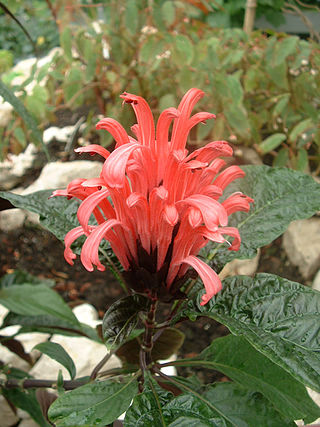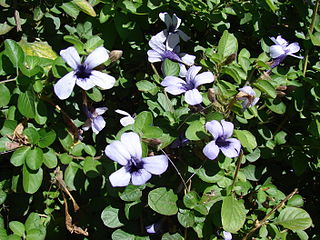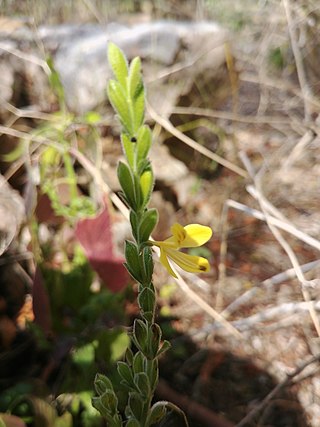
Acanthaceae is a family of dicotyledonous flowering plants containing almost 250 genera and about 2500 species. Most are tropical herbs, shrubs, or twining vines; some are epiphytes. Only a few species are distributed in temperate regions. The four main centres of distribution are Indonesia and Malaysia, Africa, Brazil, and Central America. Representatives of the family can be found in nearly every habitat, including dense or open forests, scrublands, wet fields and valleys, sea coast and marine areas, swamps, and mangrove forests.

Justicia is a genus of flowering plants in the family Acanthaceae. It is the largest genus within the family, encompassing around 700 species with hundreds more as yet unresolved. They are native to tropical to warm temperate regions of the Americas, India, and Africa. The genus serves as host to many butterfly species, such as Anartia fatima. Common names include water-willow and shrimp plant, the latter from the inflorescences, which resemble a shrimp in some species. The generic name honours Scottish horticulturist James Justice (1698–1763). They are closely related to Pachystachys.

Ruellia is a genus of flowering plants commonly known as ruellias or wild petunias. They are not closely related to petunias (Petunia) although both genera belong to the same euasterid clade. The genus was named in honor of Jean Ruelle (1474–1537), herbalist and physician to Francis I of France and translator of several works of Dioscorides.

Dicliptera is a genus of flowering plants in the bear's breeches family, Acanthaceae. It includes 223 species native to the tropics and subtropics worldwide. Well-known synonyms include Peristrophe and Dactylostegium.

Anisacanthus is a genus of flowering plants in the bear's breeches family, Acanthaceae. The generic name is derived from the Greek words ανισος (anisos), meaning "unequal," and ακανθος (acanthos), meaning "thorn." Members of the genus are native to tropical and subtropical regions of the Americas. They are commonly known as desert honeysuckles, though this term is shared with the genus Ancistranthus, and is something of a misnomer as true honeysuckles belong to the family Caprifoliaceae. Anisacanthus species are sometimes cultivated for use in xeriscaping.

Poikilacanthus is a genus of flowering plants in the family Acanthaceae.

Stenandrium is a genus of flowering plants in the family Acanthaceae native to the Americas, with 50 species of perennial herbs ranging from the southern United States to northern Argentina and central Chile.

Anisotes is a genus of Afrotropical plants in the family Acanthaceae. The genus is morphologically similar to Metarungia, from which it differs mainly in the dehiscence of the fruit capsule, and the nature of the placenta. Placentas remain attached to the inner surface of fruit capsules in Anisotes.

Odontonema, the toothedthreads, is a genus of flowering plants in the family Acanthaceae. It is native to Central America.

Pseuderanthemum is a genus of plants in family Acanthaceae with a pantropical distribution.

Stenostephanus is a genus of plants in the family Acanthaceae. It includes 94 species native to the tropical Americas, ranging from northeastern Mexico to Bolivia and southeastern Brazil.

Dyschoriste is a genus of flowering plants in the family Acanthaceae. It includes 98 species native to the tropics and subtropics of the Americas, sub-Saharan Africa, and southern Asia. Members of the genus are commonly known as snakeherb.

Bravaisia is a genus of plants in the family Acanthaceae. It includes three species of shrubs or trees native to Mexico, Central America, Colombia, Venezuela, Cuba, and Trinidad.

Schaueria is a genus of flowering plants in the family Acanthaceae. They are endemic to Brazil, from Bahia to Rio Grande do Sul. They are characterized by small elongated white or yellow flowers and narrow to thread-like green or yellow bracts. They are found mainly in rain forests, semi-deciduous mountain forests, and restingas. They are pollinated by bees and hummingbirds.
Stenandriopsis is a genus of flowering plants belonging to the family Acanthaceae. It includes 20 species native to tropical Africa and Madagascar. Molecular phylogenies have placed the Old World Stenandriopsis apart from New World Stenandrium, and the genus is accepted in a classification of the family Acanthaceae published in 2022.

Henrya is a genus of flowering plants belonging to the family Acanthaceae.

Louteridium is a genus of flowering plants belonging to the family Acanthaceae.
Mirandea is a genus of flowering plants belonging to the family Acanthaceae.
Streblacanthus is a genus of flowering plants belonging to the family Acanthaceae.















